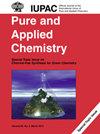Bio-based aerogel composites of coconut pith-derived carbon and chitosan for efficient anionic dye-polluted water treatment
IF 2
4区 化学
Q3 CHEMISTRY, MULTIDISCIPLINARY
引用次数: 0
Abstract
Biomass-based aerogels are of interest due to their abundant precursors, ease of functionalization, eco-friendliness, low cost, and effectiveness in dye-contaminated water treatment. Coconut pith (CP) known as a by-product after coconut processing is a sponge-like and lightweight material discarded in large volumes. For the first time, carbon micro-particles resulting from two-step treatment and pyrolysis of CP have been successfully incorporated with chitosan to produce aerogel composites by high-speed homogenization and freeze-drying. After pretreatment, holocellulose content and crystallinity index of the recovered CP pulp are respectively 75.4 and 58.6 % along with a solid recovery rate of 27.5 %. Characteristic properties of the aerogel composites are featured by their density as low as 15.23–28.17 mg/cm椰壳碳和壳聚糖生物基气凝胶复合材料用于高效处理阴离子染料污染的水体
生物质气凝胶因其丰富的前体、易于功能化、生态友好、成本低廉以及在染料污染水处理中的有效性而备受关注。椰子髓(CP)是椰子加工后的副产品,是一种类似海绵的轻质材料,被大量废弃。通过高速均质和冷冻干燥,首次成功地将椰子髓两步处理和热解产生的碳微粒与壳聚糖结合,生产出气凝胶复合材料。经过预处理后,回收的氯化石蜡浆的全纤维素含量和结晶度指数分别为 75.4% 和 58.6%,固体回收率为 27.5%。气凝胶复合材料的特点是密度低至 15.23-28.17 mg/cm3,孔隙率高达 98.17-99.05%,杨氏模量为 1.64-12.23 kPa。多孔网络、壳聚糖中的两个胺基团和碳表面与甲基橙(MO)之间的静电作用的协同效应使制成的气凝胶复合材料在初始 MO 浓度为 500 mg/L 时的吸附容量高达 454.13 mg/g,去除率为 92.32%。因此,通过可行的程序合成的椰子纤维衍生碳/壳聚糖气凝胶复合材料在提高椰子废弃物的价值和通过简单经济的吸附处理染料污染水污染方面表现出巨大的潜力。
本文章由计算机程序翻译,如有差异,请以英文原文为准。
求助全文
约1分钟内获得全文
求助全文
来源期刊

Pure and Applied Chemistry
化学-化学综合
CiteScore
4.00
自引率
0.00%
发文量
60
审稿时长
3-8 weeks
期刊介绍:
Pure and Applied Chemistry is the official monthly Journal of IUPAC, with responsibility for publishing works arising from those international scientific events and projects that are sponsored and undertaken by the Union. The policy is to publish highly topical and credible works at the forefront of all aspects of pure and applied chemistry, and the attendant goal is to promote widespread acceptance of the Journal as an authoritative and indispensable holding in academic and institutional libraries.
 求助内容:
求助内容: 应助结果提醒方式:
应助结果提醒方式:


